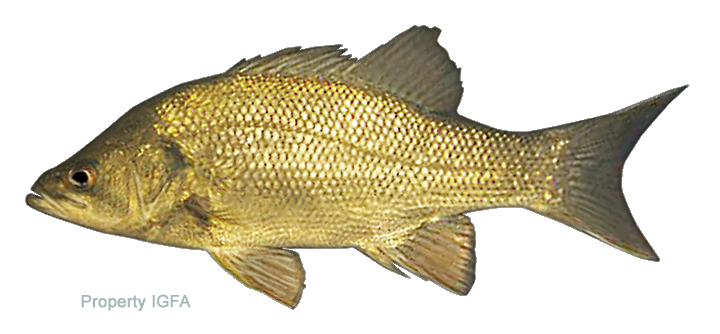Game Fish Identification Reference Guides
Bass, Australian
(Macquaria novemaculeata)
(Macquaria novemaculeata)

(Steindachner, 1866); PERCICTHYIDAE FAMILY; also known as freshwater perch, eastern freshwater perch and perch
Occurs in coastal rivers and streams along the eastern seaboard from Tin Can Bay in Queensland, south through New South Wales and into eastern Victoria. Hatchery reared fish have been stocked for recreational fishing in inland impoundments in both New South Wales and Queensland however, these landlocked fish never spawn. The Australian bass is often found far upstream in freshwater while concealed in in-stream debris, in or near weedbeds, or under rocky outcrops and undercut banks. Euryhaline bass can tolerate wide fluctuations of salinity from fresh to saltwater. This species moves out of freshwaters into saline estuaries during midwinter to spawn. The planktonic eggs are carried out to sea and swept along shorelines and eventually populate river systems.
Sometimes confused with estuary perch (Macquaria colonorum), which has an overlapping range, bass may be differentiated from estuary perch by white edges to anal and pelvic fins, and more rounded and streamlined head and body profile. The back and sides of the bass are dark green, whereas the perch is silvery and has a slight hump on the head just behind the eye. The tail is forked and the two dorsal fins are deeply notched, almost forming two separate fins
Australian bass is an outstanding freshwater sportfish. It will respond to similar angling methods employed for trout and will easily outfight trout of a similar size. They are prized for their tenacious fighting ability, explosive surface strikes and willingness to take flies and lures as well as bait.
On the table, Australian bass is first-class fare, the flesh is firm with good texture
Occurs in coastal rivers and streams along the eastern seaboard from Tin Can Bay in Queensland, south through New South Wales and into eastern Victoria. Hatchery reared fish have been stocked for recreational fishing in inland impoundments in both New South Wales and Queensland however, these landlocked fish never spawn. The Australian bass is often found far upstream in freshwater while concealed in in-stream debris, in or near weedbeds, or under rocky outcrops and undercut banks. Euryhaline bass can tolerate wide fluctuations of salinity from fresh to saltwater. This species moves out of freshwaters into saline estuaries during midwinter to spawn. The planktonic eggs are carried out to sea and swept along shorelines and eventually populate river systems.
Sometimes confused with estuary perch (Macquaria colonorum), which has an overlapping range, bass may be differentiated from estuary perch by white edges to anal and pelvic fins, and more rounded and streamlined head and body profile. The back and sides of the bass are dark green, whereas the perch is silvery and has a slight hump on the head just behind the eye. The tail is forked and the two dorsal fins are deeply notched, almost forming two separate fins
Australian bass is an outstanding freshwater sportfish. It will respond to similar angling methods employed for trout and will easily outfight trout of a similar size. They are prized for their tenacious fighting ability, explosive surface strikes and willingness to take flies and lures as well as bait.
On the table, Australian bass is first-class fare, the flesh is firm with good texture












